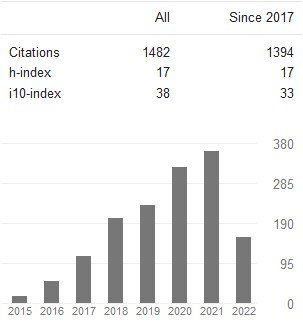Anticandidal activity of essential oils of Myristica fragrans and Syzygium aromaticum
Abstract
M. fragrans is commonly known as nutmeg. S. aromaticum is called as clove. In Siddha medicine, these are used as one of the ingredients in medicines that are used to treat vaginal diseases. The aim of the study was to evaluate the anticandidal activity of oils of seed and leaf of M.fragrans and clove against C. tropicalis ATCC 13803, C. krusei ATCC 6258, C. albicans ATCC 90028, C. glabrata ATCC 90030, C. parapsilosis ATCC 22019, C. albicans 3 clinical isolates. Oils were distilled using the Clevenger apparatus. Anticandidal activity of oils was screened using disc diffusion method. Minimum Inhibitory Concentration (MIC) of the oils was determined in two different method of two fold micro-broth dilution. Minimum Bactericidal Concentration (MBC) was determined wells with no turbidity in the micro-broth MIC method (BHI) were sub cultured onto a blood agar plate. All three oils showed activity against all tested Candida sp ZOI from 8.3 ± 0.5 - 30.0 ± 0.0mm. MIC of three oils are similar for all tested Candida sp in both methods. The extremely low MIC (0.0045µg/mL) of the oil of S. aromaticum for all the tested Candida strains is note worthy. However, all the tested oils were active against Candida with MICs ranging from 0.0045 –2.5 µg/mL. MBC was the same or differed by only one dilution as the MIC for tested Candida sp. suggesting that the oils are fungicidal. Three oils have ability to inhibit Candida sp with low MIC
Keywords:
Anticandidal activity, essential oils, Myristica fragrans, Syzygium aromaticumDownloads
Published
How to Cite
Issue
Section
Copyright (c) 2018 Thayalini Thileepan, Vasanthi Thevanesam, Selvaluxmy Kathirgamanathar. S

This work is licensed under a Creative Commons Attribution-NonCommercial-ShareAlike 4.0 International License.



 Journal of Innovations in Pharmaceutical and Biological Sciences is licensed under a Creative Commons Attribution-NonCommercial-ShareAlike 4.0 International License. Based on a work at
Journal of Innovations in Pharmaceutical and Biological Sciences is licensed under a Creative Commons Attribution-NonCommercial-ShareAlike 4.0 International License. Based on a work at